Welcome again! This page is dedicated to the plants I found and identified on our field trip to Darby Creek with the help of my many field guides (Peterson Field Guide for trees and shrubs, and Newcomb’s Wildflower Guide). Pictured and described below are multiple kinds of plants ranging from trees to flowers, some native and some invasive. Though I may have taken the word ‘trip’ too literally, this was a fun adventure, and I will certainly be returning to the park in the future, hopefully with more steady footing.
The geography of Ohio is roughly split into two distinct areas with different geobotanies: Eastern and Western Ohio. Western Ohio is comprised of limestone and magnesium minerals throughout the soil, and since those minerals don’t fare well against humidity, the area has become rather flat over time. But in Eastern Ohio, the ground is comprised of sandstone and shale. Sandstone is very weather resistant, and shale is not; however, when shale is capped with sandstone, it is protected against the elements. Because of this combination, areas of only shale have become valleys while other regions have steep hillsides.
As mentioned above, Ohio’s ground is made primarily of a few kinds of sedimentary rocks, with limestone being on the bottom, then shale, then sandstone on top. This was tilted into a low arch because of pressure within the crust (the same pressure that had formed the Appalachian Mountain range approx. 200 million years ago). Erosion was worst at the highest point of the newly created arch which exposed the oldest layer of rocks (running north and south along the western side of the state), which is weak against the elements, and wore the land down to flat plains. However, on the eastern side, the younger and stronger sandstone was on top, which is greatly resistant to erosion, and the only underlaying layers were revealed because of cracks in the crust. Because of this, the eastern half is sandstone hills with deep limestone valleys. The majority of the erosion on the western half is due to a prehistoric preglacial river named the Teays River. This river eroded the landscape for almost 200 million years under the Ice Age glaciers came through.
These glaciers did not erode the land forever; they were slowed down by the steep hills on the eastern side of the state. The glacial boundary extends as far south as Northern Kentucky but only on the western limestone side, and on the eastern sandstone side, the boundary is much further north. These glaciers left behind till, or a loose mixture of boulders, clay, silt, and sand, which was accumulated by the melting of the ice within the glacier. The other kind of till is comprised of sand and gravel from meltwater deposits. These different types of tills are responsible for the different contents of the regions’ soils: west getting their limestone and clay, and the east getting their sand and gravel. The dividing line between east and west is where the limestone containing till was mostly stopped by the resilient sandstone hills.
Because of the difference in soil compositions, differently adapted plants appear in either region. In Western Ohio, the till of limestone and clay is relatively impermeable, so it drains poorly and is poorly aerated. This means that water has a hard time soaking into the ground, leaving oxygen deficient soil during long dry spells. Where the glacial till is minimal, there’s plenty of plant nutrients, as limestone is water-soluble. On the eastern side, the exposed sandstone and bedrock creates an acidic environment with low nutrients available for plants. However, in lower regions of valleys, there’s plenty of water year-round as it comes down from the springs and permeates through the sandstone. The shale, though also producing low nutrient and high acidity environments, does not allow water permeation, so the water tends to run off, which can cause droughts during long dry spells.
In portions of Ohio with high limestone concentrations (like the Lake Erie region), there’s a number of plants adapted for life in those conditions. Examples include Redbuds, Fragrant Sumac, Hackberry, Blue Ash, and Chinquapin Oaks. On the Western side of the state, with the high-lime and high-clay soil, there’s different species adapted for that specific lifestyle. Species such as Sugar Maple, Beech, Red Oak, White Oak, and White Ash are all regional examples. On the Eastern side of Ohio, with the numerous sandstone hills, other species found a way to survive. Tree and shrub species like Chestnut Oak, Sourwood, Hemlock, Huckleberry-Blueberry, and Greenbrier have adapted best for these sandstone-y conditions.
Some plants like to be different distributions from the norm, such as Sweet Buckeye trees. We aren’t sure why they aren’t found inside the glacial boundary or north of it, perhaps due to repopulation issues post Ice Age, or climate conditions instead of soil conditions. On the contrary, Hemlock, while also not being within the glacial boundary, extends further north of it. This is likely because Hemlock requires cool and moist environments for survival. For even more uniqueness, some plants are found even further south of the boundary, which may be because of mixed mesophytic associations. Rhododendrons is a great example of this. This species is thought to be one remaining from the Appalachian highlands that was moved south with the River Teays. The plants that were best equipped to adapt to this movement survived.
Now that we’ve gotten some geobotany and history lessons out of the way (thanks to the article ‘Linking Geology and Botany…a new approach’ by Jane L Foster), it’s time to present some plants I catalogued during my adventure.
The first picture is of a common woodland Phlox (Phlox divaricata), which is a member of the Polemoniaceae family. This family is characterized by alternate leaves that are toothed or shallowly lobed as well as regular flowers with five petals. The word ‘Phlox’ comes from its Greek partner meaning ‘flame’, since some of the flowers of this species have vibrant colors. This particular one has pretty pale purple flowers, but the next one has more of a blue tint to them.
This flower is also part of the Phlox family. Commonly called Jacob’s Ladder, this flower has more blue to it than the former. The petals are much closer together here and are more rounded than long, and the leaves are pinnate with many leaflets. Both of these are native to Ohio!
Next on the list are two unfortunately invasive species. The first one is a personal foe of mine. The Amur Honeysuckle (Lonicera maackii), is commonly planted as an ornamental plant, but because it blooms much earlier than many native plants, it overtakes far too much land and resources. This was disappointing to learn when I was younger because I had these growing in my childhood home’s backyard. Even though they try to take up residence in my backyard now, we do our best to cut them down before they become problems for the native animals and plants.
The second plant on the invasive list docket is Garlic Mustard (Alliaria officinalis). It gets its name from the garlic like smell it emits when you crush its leaves, but it isn’t actually in the garlic family. This mustard plant can be used to make pestos with (according to my classmates), but it should be done earlier in the season before it becomes too bitter. I did not know these were invasive when I found them in my dad’s yard, but now that I know, I’ll be making some pesto out of these.
These last four plants are all trees that are called calciphiles. They get this name because they thrive in calcium rich environments like western Ohio thanks to the prevalence of limestone in the soil.
The first calciphile is the Fragrant sumac (Rhus aromatica). A member of the thornless trifoliates, they get their name from the pleasant fragrance they emit when you scratch their leaves (as Prof Klips said, they’re like scratch-and-sniff stickers). Unfortunately, they look very similar to both poison ivy and poison oak, all of which belong to the Anacardiaceae, or Cashew, family. The best difference I know of is that the good kind isn’t hairy, has hidden buds, and does not have aerial roots.
The next tree on the list is the American Hackberry (Celtis occidentalis). Their wood is similar to that of Ash trees, and its berries are a common snack among many kinds of birds. The most notable feature of this tree that I remember is the uneven bases of the lobed leaves, which I don’t think of as a common feature in many plants. These trees are commonly found in most of Ohio’s floodplains, which are suspected to have deposited dissolved limestone across the region.
Just like the other calciphiles, the Blue Ash (Fraxinus quadrangulata) tree is common around western limestone-y Ohio but is most populous near the Erie islands. These trees are best separated by their square like twigs and shield shaped leaf scars. Their inner bark can be used to make blue dye! Someday I’ll have to make a list of all the plants I know that can be used for dye and test them out.
The last plant on the list of calciphiles is the Chinquapin oak (Quercus muehlenbergii). This oak stands out from others because of it’s almost wavy lobed leaf margins with long fatten leaves. The light gray and flakey bark helps separate it from similar species like Chestnut Oak. As common with many other oak trees, it’s wood can be used for building.

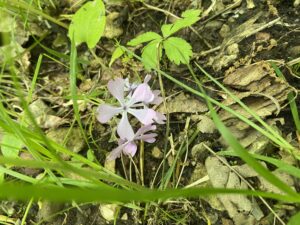
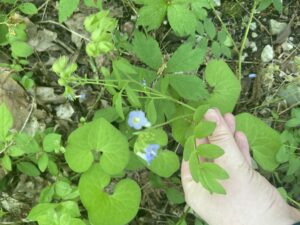
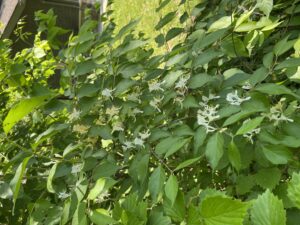
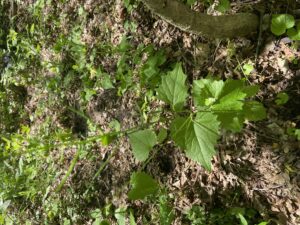
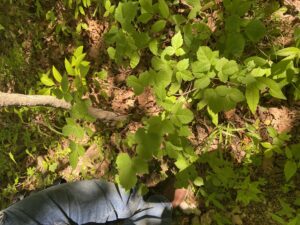
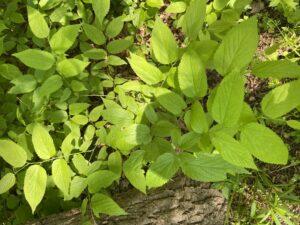
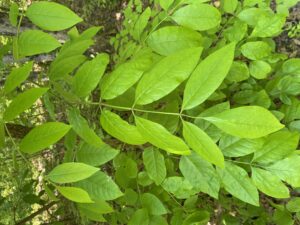
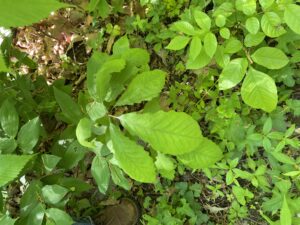
Comments
Battelle-Darby Creek Field Trip — No Comments